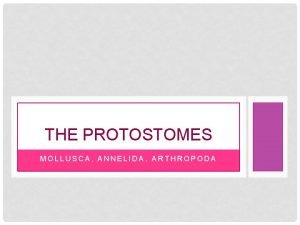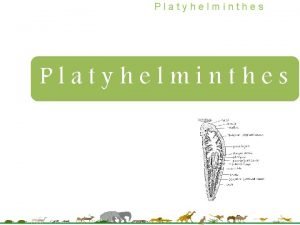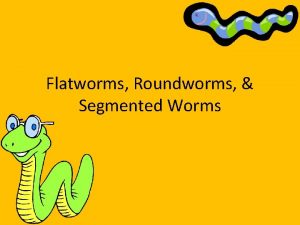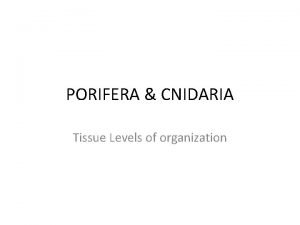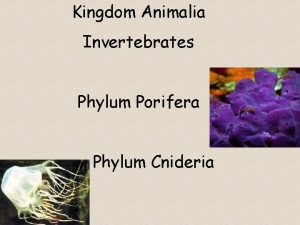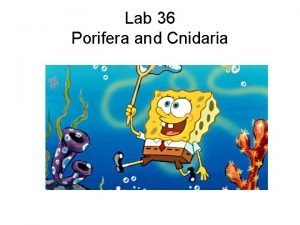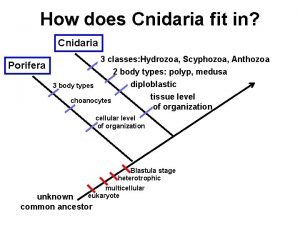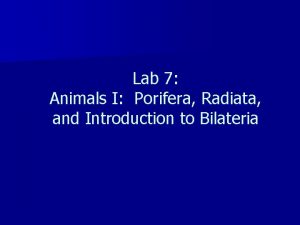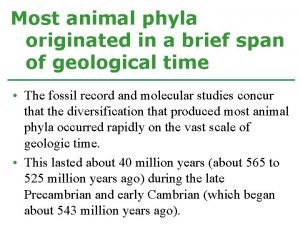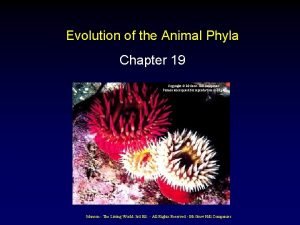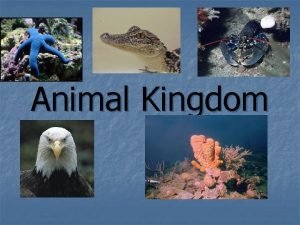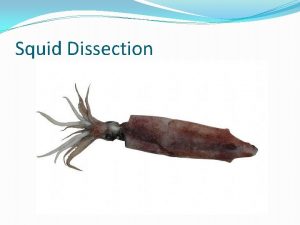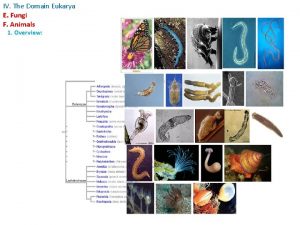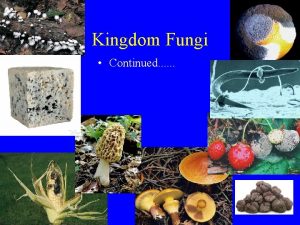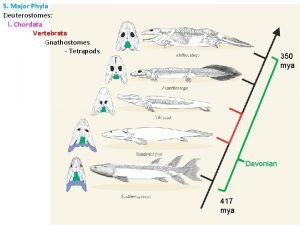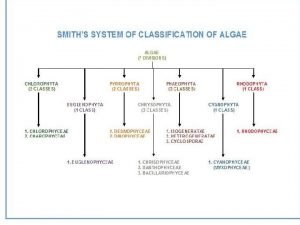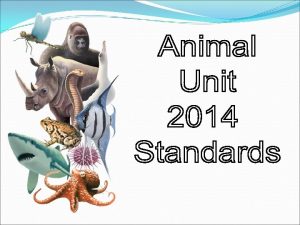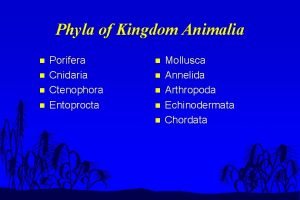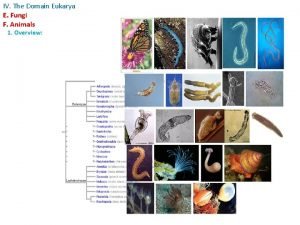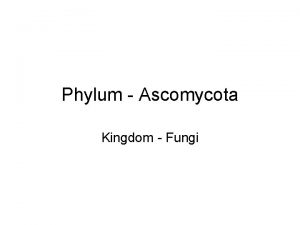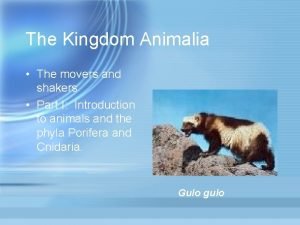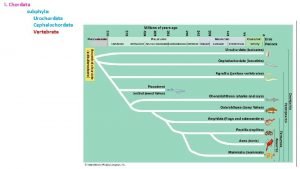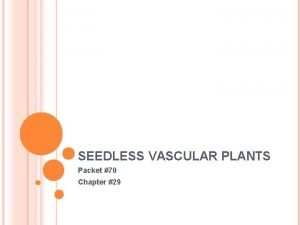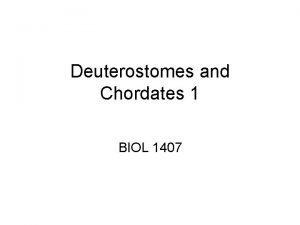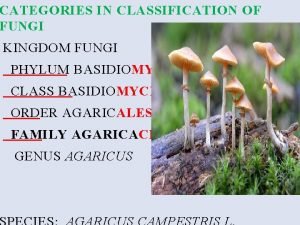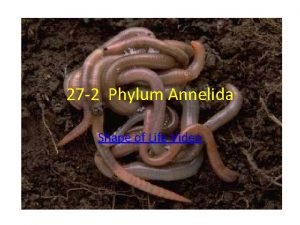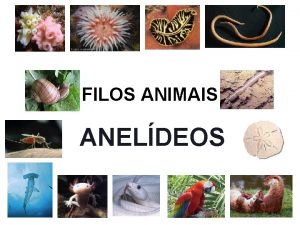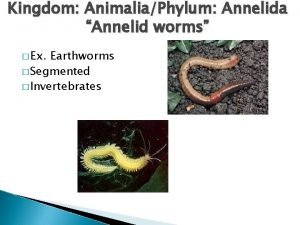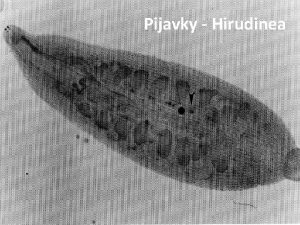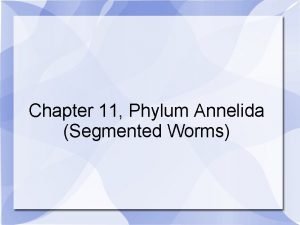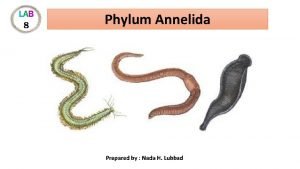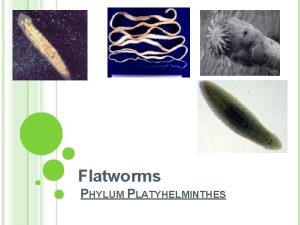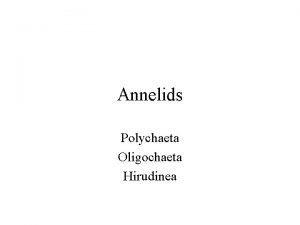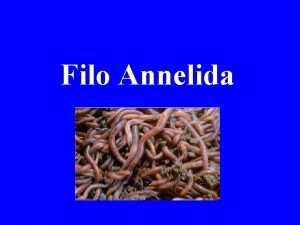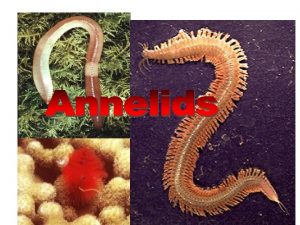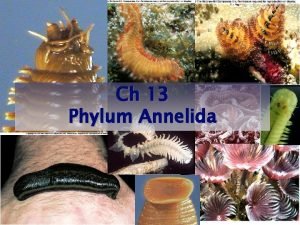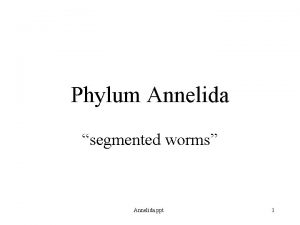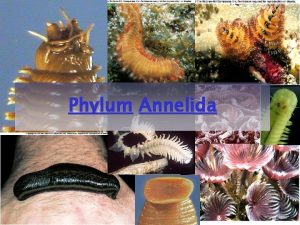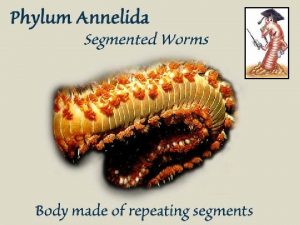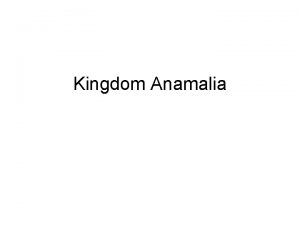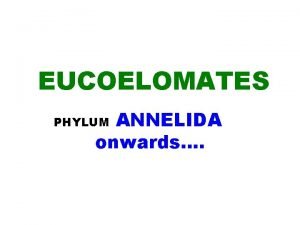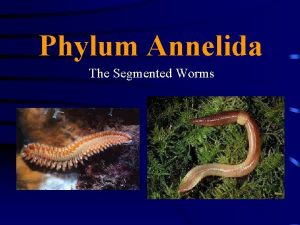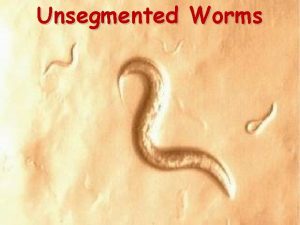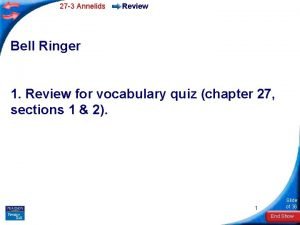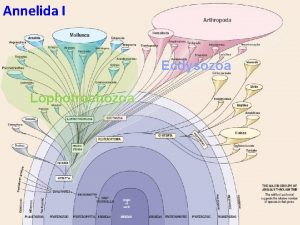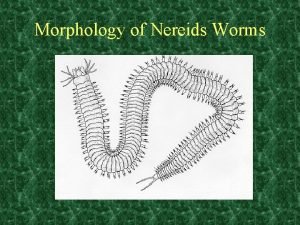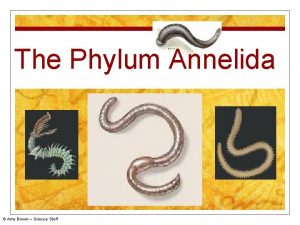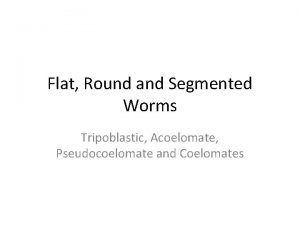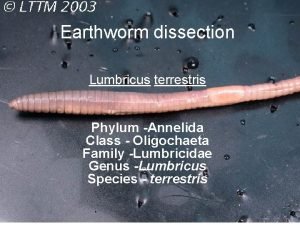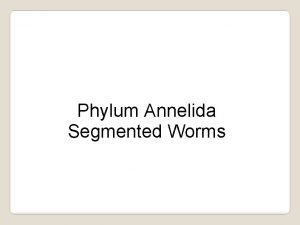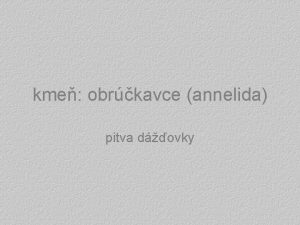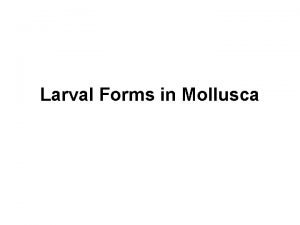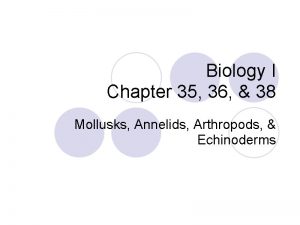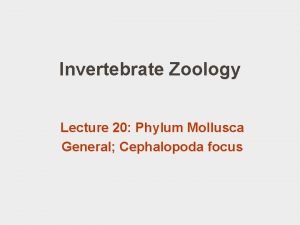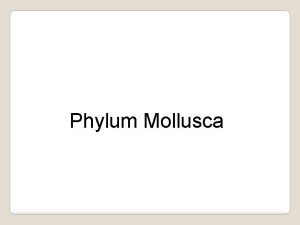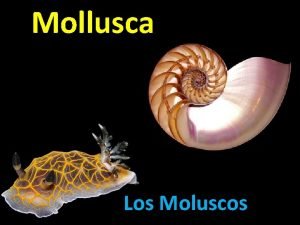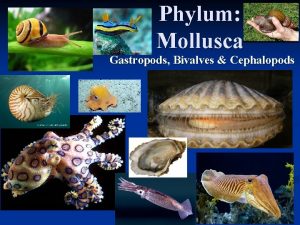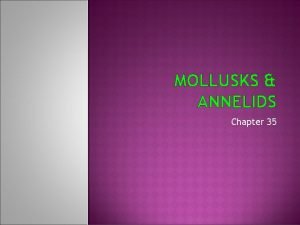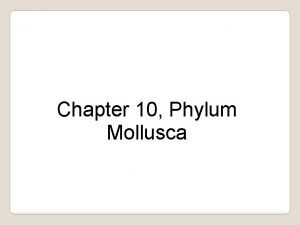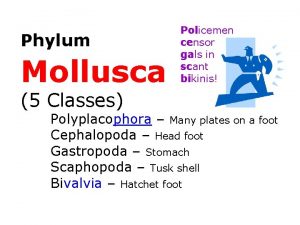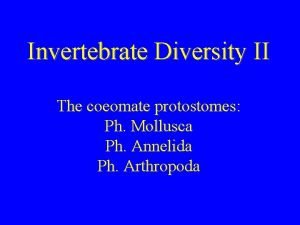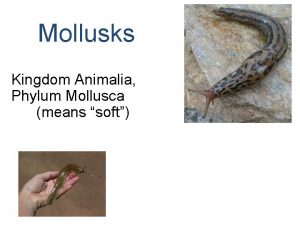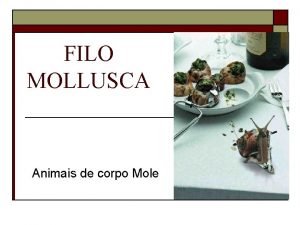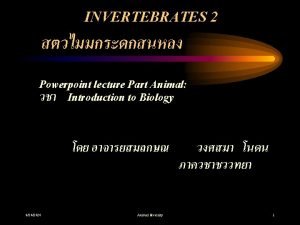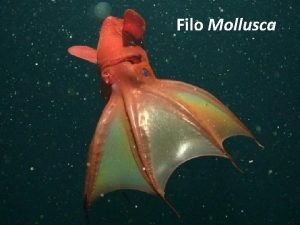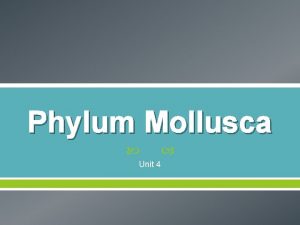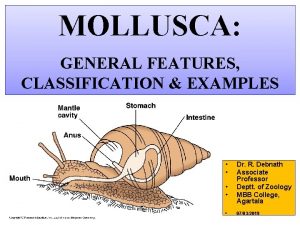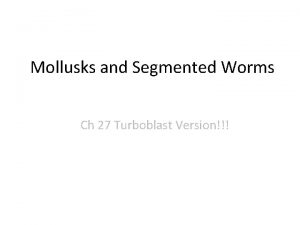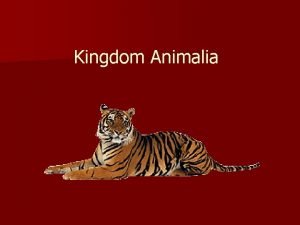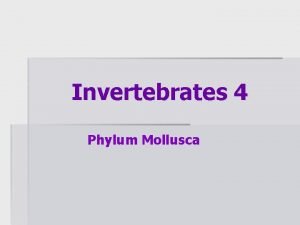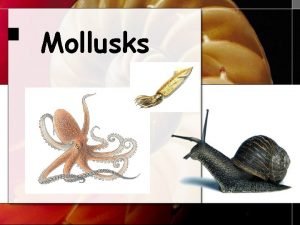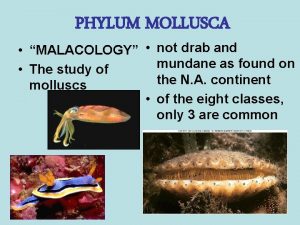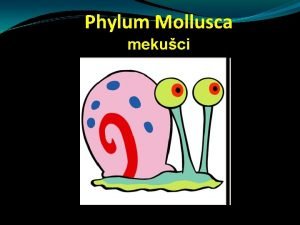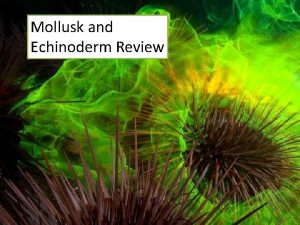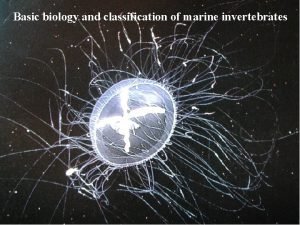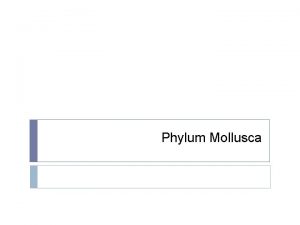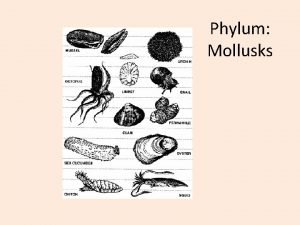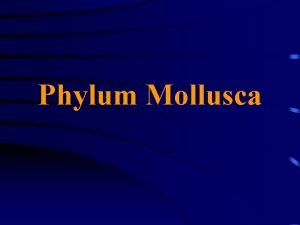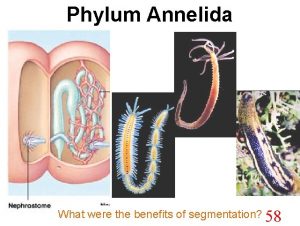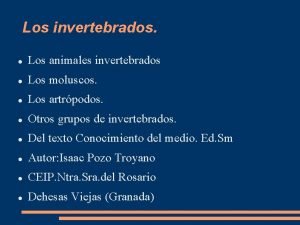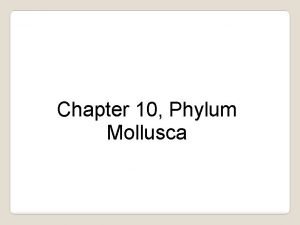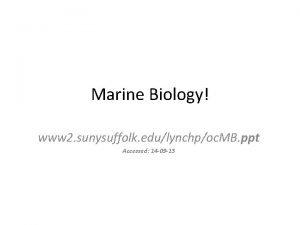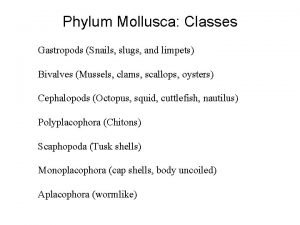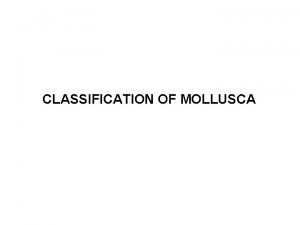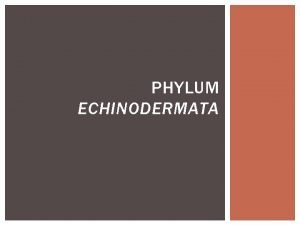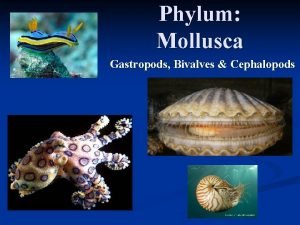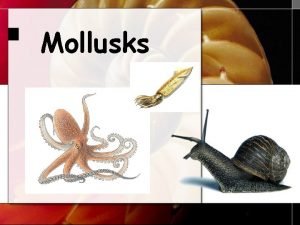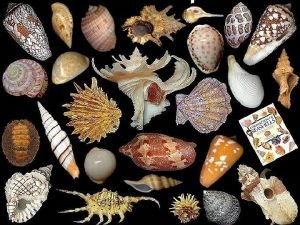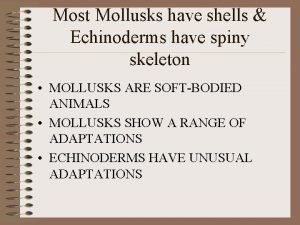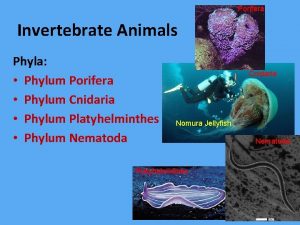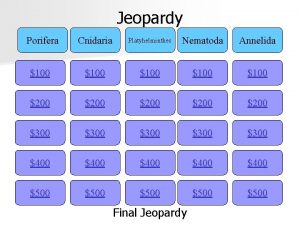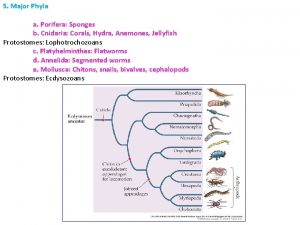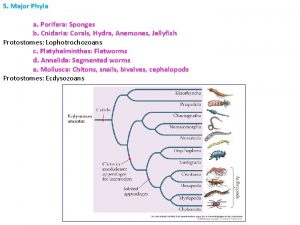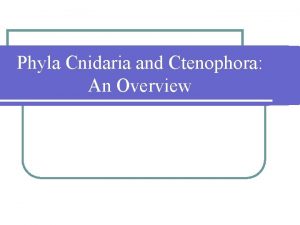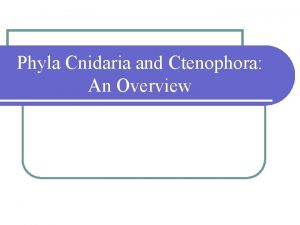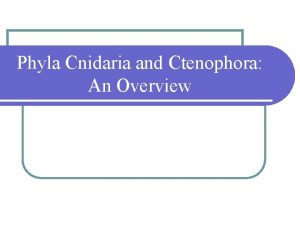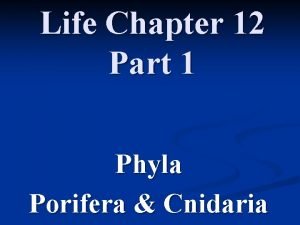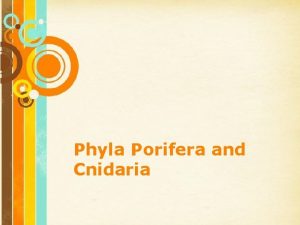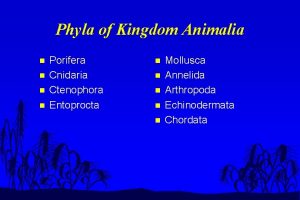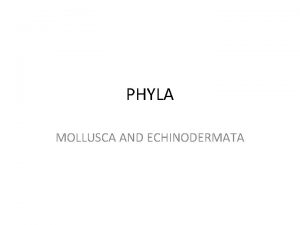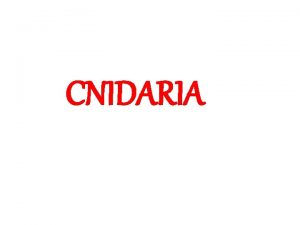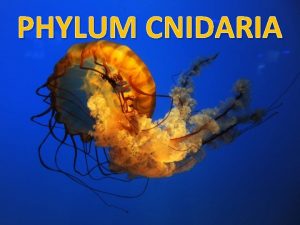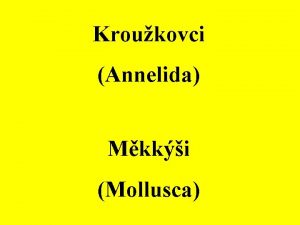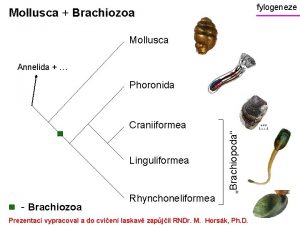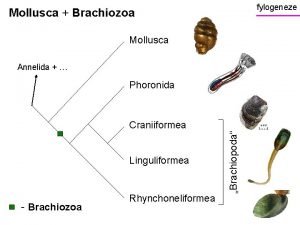Major Animal Phyla Porifera Cnidaria Platyhelminthes Annelida Mollusca


















































































































- Slides: 114

Major Animal Phyla Porifera, Cnidaria, Platyhelminthes, Annelida, Mollusca, Arthropoda, Echinodermata, and Chordata

Phylum Porifera sponges • • • Have no definite shape – asymmetrical; No tissues or organs Colony of specialized cells Immobile Good powers of regeneration Skeleton of spongin and spicules

CLASSES OF SPONGES • Class Calcarea – has calcium carbonate spicules • Class Hexactinellida – glass sponges with spicules of silica • Class Demospongiae – no spicules, only spongin

SPONGE ANATOMY




Barrel sponge

Vase sponge

Tube sponge

Venus Flower Basket

Phylum Cnidaria stinging-celled animals • • • Jellyfishes, corals, anemones Radial symmetry Two tissue layers with inner mesoglea Primitive nerve net but no brain 2 -way digestive tract Stinging cells for capturing food.

CLASSES OF CNIDARIANS • Class Hydrozoa – Hydra, Portuguese-Man -of-War, Obelia; mostly polyp or hydroid stage • Class Scyphozoa – true jellyfishes; mostly medusa stage • Class Anthozoa – corals, anemones • Class Cubozoa – box jellies

CLASS HYDROZOA Hydra

CLASS SCYPHOZOA

Moon jelly

CLASS ANTHOZOA

Sea anemone

Aggregating anemones

Anemone

Coral polyps

Coral reef

CLASS CUBOZOA

Phylum Platyhelminthes flatworms • First animals to exhibit bilateral symmetry • Have primitive brain • 3 tissue layers • Includes free-living flatworms and parasitic flatworms (tapeworms, flukes)

CLASSES OF FLATWORMS • Class Turbellaria – free-living flatworms • Class Cestoda – tapeworms • Class Trematoda - flukes


Flatworm

Flatworm

Flatworm

Tapeworm head (scolex)

Liver fluke

Phylum Annelida segmented worms • Earthworms, sandworms, leeches • One-way digestive system • Have well-developed digestive and circulatory systems

CLASSES OF ANNELIDS • Class Oligochaeta – earthworms, bloodworms; oligo- means “few” and chaeta means a “bristle” or stout hair • Class Polychaeta – many bristles and parapodia (fleshly lobes to “walk” with • Class Hirudinea – leeches (most are NOT bloodsuckers)

Christmas tree worm

Feather-duster worm

Fireworm

Nereis – a polychaete

Oligochaete

Leech

Phylum Molluscasoft bodied animals • includes snails, slugs, nudibranchs, chitons, limpets, clams, oysters, squid, octopus, nautilus, etc. • Either have no shell, one shell, or two shells • Many have hard mouth parts (radula in gastropods, beak in cephalopods).

CLASSES OF MOLLUSCS • Class Gastropoda – snails, slugs, conchs, nudibranchs; have either no shell or one shell; name means “stomach foot” • Class Bivalvia – clams, oysters, mussels; have two shells that hinge together • Class Polyplacophora – chitons; snail-like with 8 embedded plates on its back • Class Cephalopoda – squid, octopus, nautilus, cuttlefish; name means “head foot”; welldeveloped nervous system

Nudibranch

Nudibranch

Nudibranch

Chiton

Chiton

Reef Squid

Cuttlefish

Blue-ring octopus

Chambered nautilus

Triton shell

Oyster on half-shell (needs Tabasco)

Scallop

Phylum Arthropoda – joint-legged animals • includes insects, crustaceans, centipedes, millipedes, and arachnids • exoskeleton made of chitin • must shed shell to grow

CLASSES OF ARTHROPODS • Class Crustacea – shrimps, lobsters, crabs, crawfishes • Class Amphipoda – small; called scuds • Class Isopoda – sea lice; some are parasitic • Class Stomatopoda – mantis shrimps • Class Pycnogonida – sea spiders • Class Merostomata – horseshoe crabs • Class Cirripedia - barnacles

Bulldozer larva - Crustacea

Bulldozer

Cleaner shrimp Crustacea

Spider crab Crustacea

Crab zoea crustacea

Crab megalops

Stone crab

Hermit crab - crustacea

Amphipoda

Giant Isopod

Parasitic isopod

Ligia exotica - isopod

Mantis shrimp - Stomatopoda (thumbsplitter)

Horseshoe crab Merostomata

Sea spider- Pycnogonida

Barnacles - Cirripedia

Phylum Echinodermata – spiney-skinned animals • includes sea stars, brittle stars, sea urchins, sand dollars, sea cucumbers, and crinoids • reverted back to radial symmetry (radial in adults / bilateral in larvae) • tube feet and water vascular system • Most exhibit pentamerism

WHY ARE ECHINODERMS RANKED SO HIGH? • Clues from embryology – study of the early development of animals • Protostomes versus Deuterostomes • Protostome – blastopore forms the mouth in all animals except echinoderms and chordates • Deuterostomes – blastopore forms the anus in echinoderms and chordates


CLASSES OF ECHINODERMS • Class Asteroidea – sea stars • Class Ophiuroidea – brittle stars, serpent stars • Class Echinoidea – sea urchins, sand dollars • Class Holothuroidea – sea cucumbers • Class Crinoidea – sea lilies, feather stars

Sea star - Asteroidea

Bat star Asteroidea

Pycnopodia - Asteroidea

Brittle star - Ophiuroidea

Sea urchin - Echinoidea

Purple urchins Echinoidea

Sand dollar - Echinoidea

Sea cucumber Holothuroidea

Feather star - Crinoidea

Phylum Chordata • Includes fish, amphibians, reptiles, birds, and mammals • Chordate characteristics: • Dorsal hollow nerve tube • Notochord • Pharyngeal gill slits • Post anal tail

CHORDATE CLASSIFICATION • The Protochordates - invertebrate chordates • Subphylum Urochordata – sea squirts, salps, and ascidians • Subphylum Cephalochordata – lancelets • True Chordates: • Subphylum Vertebrata


Tunicate - Urochordata

Tunicate - Urochordata

Salp- Urochordata

CEPHALOCHORDATE Amphioxus

SUBPHYLUM VERTEBRATA • Class Agnatha – jawless fishes; lampreys and hagfishes • Class Chondrichthys – cartilaginous fishes; sharks, rays, skates, chimeras • Class Osteichthys – boney fishes • Class Amphibia – frogs, salamanders • Class Reptila – turtles, snakes, lizards, and crocodilians • Class Aves – birds • Class Mammalia - mammals

VERTEBRATE BODY PLAN • Recapitulation Theory – Ontogeny recapitulates Phylogeny • The embryological and developmental changes an organism goes through restates its evolutionary history • Evolution cannot go back and change history…it can only modify what is preexisting


Sea lamprey - Agnatha

Hagfish - Agnatha

Great white shark - Chondrichthys

Tiger shark - Chondrichthys

Manta ray - Chondrichthys

Stingray - Chondrichthys

Ratfish (Chimera)- Chondrichthys

Electric ray - Chondrichthys

Leafy sea dragon - Osteichthys

Sargassum fish - Osteichthys

Deep sea angler fish - Osteichthys

Clown anemone fish - Osteichthys

Bull dolphin - Osteichthys

Bullfrog - Amphibia

Green sea turtle Reptila

American alligator - Reptila

Osprey - Aves

Great blue heron - Aves

Humpback whales - Mammalia

Sea lion Mammalia
 Chondrichthys
Chondrichthys Mollusca annelida arthropoda
Mollusca annelida arthropoda Struktur tubuh oligochaeta
Struktur tubuh oligochaeta How are flatworms roundworms and segmented worms alike
How are flatworms roundworms and segmented worms alike Cnidarian level of organization
Cnidarian level of organization Cnideria examples
Cnideria examples Porifera cnidaria
Porifera cnidaria Basal disc
Basal disc Cephalization porifera
Cephalization porifera Radiata animals
Radiata animals Cnidaria
Cnidaria Acoleomate
Acoleomate Copyright
Copyright 8 phyla of invertebrates
8 phyla of invertebrates Cladogram of animal kingdom
Cladogram of animal kingdom Animals that have no bones
Animals that have no bones Squid taxonomy
Squid taxonomy Fungi
Fungi Fungi
Fungi Phyla deuterostomes
Phyla deuterostomes Endosporic development
Endosporic development Trichomes of blue green algae lack
Trichomes of blue green algae lack Eumycophyta
Eumycophyta Millipedes phylum
Millipedes phylum 35 phyla
35 phyla Karakteristik animalia
Karakteristik animalia Phyla
Phyla Asci in fungi
Asci in fungi Nine phyla of kingdom animalia
Nine phyla of kingdom animalia Vertebrata
Vertebrata Seedless vascular plants phylum
Seedless vascular plants phylum Phyla deuterostomes
Phyla deuterostomes Fungi kingdom classification
Fungi kingdom classification Shape of life annelids
Shape of life annelids Simetria annelida
Simetria annelida Earthworms kingdom
Earthworms kingdom Annelid body plan
Annelid body plan Reino annelida
Reino annelida Animalia annelida hirudinea
Animalia annelida hirudinea Importance of phylum annelida
Importance of phylum annelida Nematoda examples
Nematoda examples Annelids
Annelids Simplest bilateral animals
Simplest bilateral animals Phylum and class
Phylum and class Annelid body plan
Annelid body plan Nematode vs annelid
Nematode vs annelid Nefrídeos
Nefrídeos Class sedentaria
Class sedentaria Subclass oligochaeta
Subclass oligochaeta Annelida ppt
Annelida ppt Phylum
Phylum Proterostomes
Proterostomes Annelida unicellular or multicellular
Annelida unicellular or multicellular Coelon
Coelon Eucolomate
Eucolomate Characteristics of annelids
Characteristics of annelids Unsegmented flatworm
Unsegmented flatworm Restperation
Restperation Ecdysozoa lophotrochozoa
Ecdysozoa lophotrochozoa Tema digestivo incompleto
Tema digestivo incompleto Morphology of annelida
Morphology of annelida Prostomium
Prostomium Trematoda
Trematoda Moniligaster
Moniligaster Lumbricus dissection
Lumbricus dissection ミミズ 解剖図
ミミズ 解剖図 Cefalizacija
Cefalizacija Larval form of mollusca
Larval form of mollusca Oligocheta
Oligocheta Mollusca
Mollusca Filos animais
Filos animais What is visceral mass in molluscs
What is visceral mass in molluscs Mollusca bilateral symmetry
Mollusca bilateral symmetry Mollusca
Mollusca Mollusca body plan
Mollusca body plan Mollusca
Mollusca Gastropods
Gastropods Characteristics of phylum mollusca
Characteristics of phylum mollusca Charneira moluscos
Charneira moluscos Umbo mollusca
Umbo mollusca Mollusca protostome or deuterostome
Mollusca protostome or deuterostome What phylum
What phylum Mollusca kingdom
Mollusca kingdom Hemocelas
Hemocelas Parasitism phylum
Parasitism phylum A pérola é uma secreção do manto ou pálio.
A pérola é uma secreção do manto ou pálio. Introduction of mollusca
Introduction of mollusca Mollusca
Mollusca Phylum mollusca homework and study guide #1
Phylum mollusca homework and study guide #1 Mollusks segmentation
Mollusks segmentation Multicellular characteristics
Multicellular characteristics Mollusca class
Mollusca class Phylum mollusca
Phylum mollusca Bivalvia phylum
Bivalvia phylum Mollusca
Mollusca Gradja puza
Gradja puza Mollusca endoskeleton
Mollusca endoskeleton Mollusca subphylum
Mollusca subphylum Mollusca
Mollusca 3 classes of mollusks
3 classes of mollusks Neopalina
Neopalina Gastropod segmentation
Gastropod segmentation Animales invertebrados moluscos
Animales invertebrados moluscos Gastropoda characteristics
Gastropoda characteristics Mollusca class
Mollusca class Mollusca
Mollusca Classes in phylum mollusca
Classes in phylum mollusca Neopilina belongs to
Neopilina belongs to Are mollusca bilateral symmetry
Are mollusca bilateral symmetry Echinodermata endoskeleton
Echinodermata endoskeleton Parasite classification
Parasite classification Phylum
Phylum Mollusca body plan
Mollusca body plan Mollusca adalah
Mollusca adalah Mollusca skeletal system
Mollusca skeletal system

